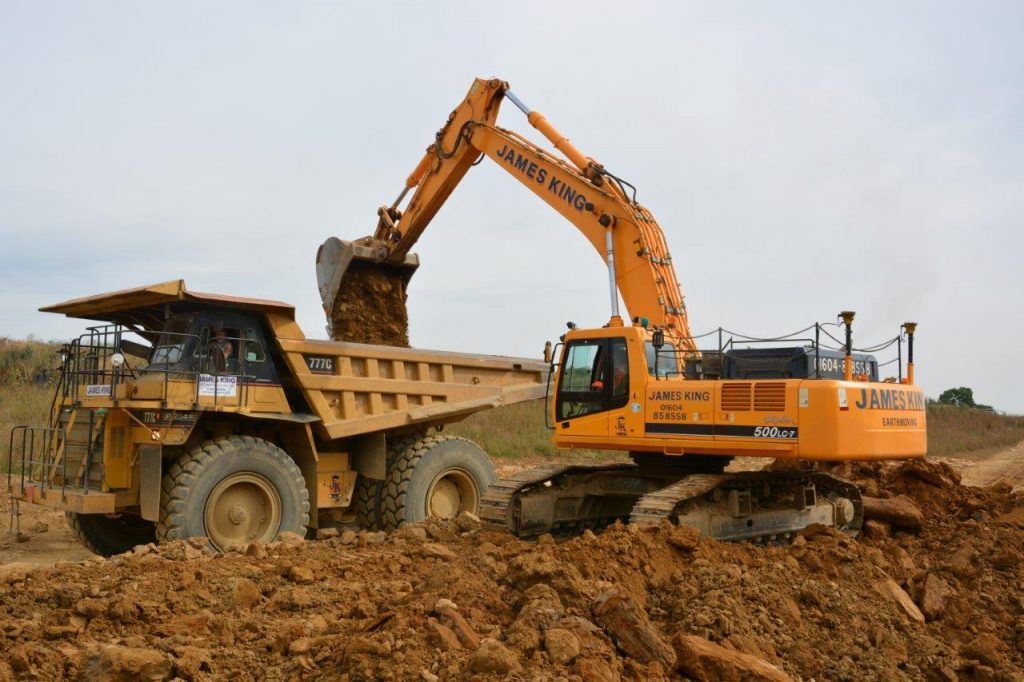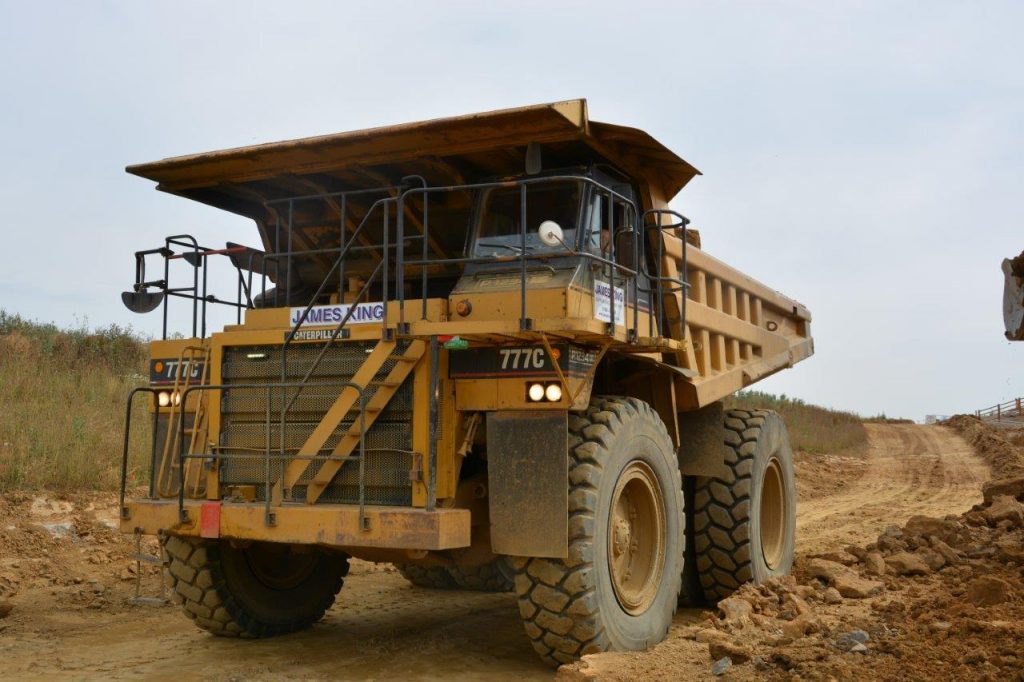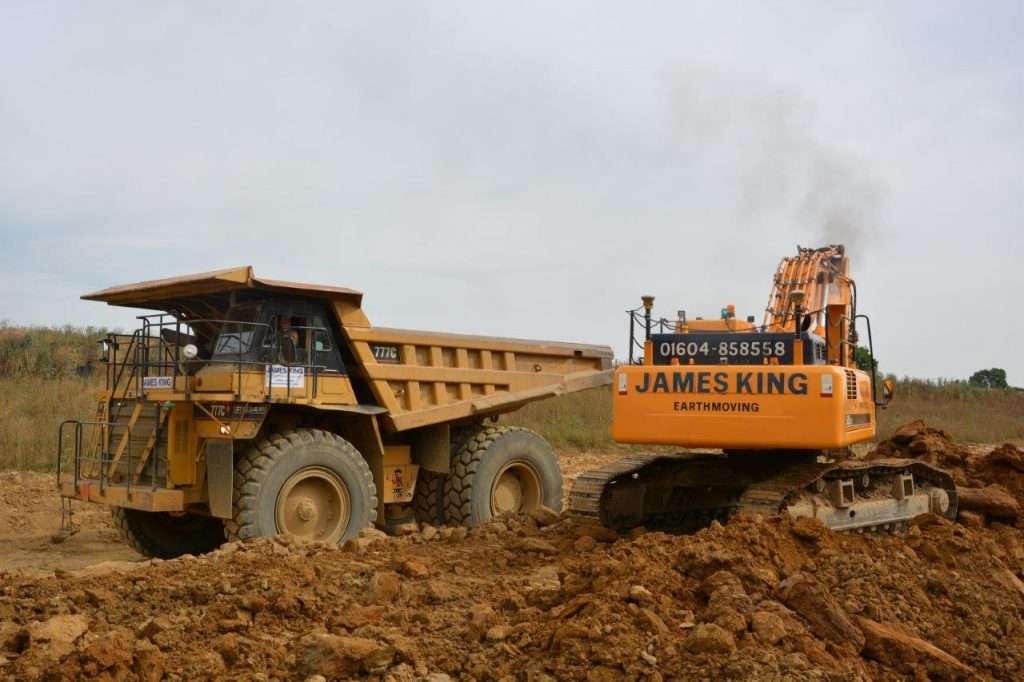by Nick Drew | Wed 23 May 2018
3 Kings, 3 Classic Cats
Taking a look back at one of my previously published articles in Earthmovers with this one from last year.
Although sometimes seen on road building jobs in Central European countries, it is very rare to see 100 tonne class rigid dump trucks deployed to work on a muck shifting job in the UK. However, when ground conditions looked favourable on a recent job, Northampton based James King Plant invested in 3 ex UK Coal Caterpillar 777Cís to shift the muck in record time.
The job in question was the £32 million Flore and Weedon A45 bypass scheme, otherwise known as the Daventry Development Link. This long-awaited 3.5-mile long (5.7km) single carriageway road will bring relief to the villages in the west of the county that have long been affected by heavy traffic heading to and from the industrial hub of Daventry and will provide much improved access to the M1 at junction 16. 
The project has been designed so that it can be expanded to a dual carriageway if needed in the future and involves the construction of 5 bridges, including river and railway crossings and two roundabouts. James King Plant is engaged in all the major earthworks with an estimated 450,000 cubic metres of muck to shift in a cut and fill operation. Initial ground reports suggested that once the top layer of soil was removed the ground below was largely made up of rock and stone material. It was these ground conditions that got the King boys thinking of investing in a fleet of three Caterpillar 777C’s, which were available in the Euro Auction for relatively small money. With an estimated 8,000 truck movements predicted using conventional ADT’s, the big rigid trucks would cut that movement figure drastically.

Seamus King, who is responsible for most of the plant purchasing on the family run business, selected the trucks at the auction and arranged transport down to the jobsite. The initial reaction to the trucks from the main contractor was one of scepticism as Pat King explained, “In all fairness they took some convincing that the trucks were right for the job, but they gave us the go ahead to use them and once we got cracking with them they quickly realised how much production was going to be possible. In one two mile cut the Hyundai R 500LC-7 and 777C combo just ate their way through it in record time, in fact we were doing the equivalent of a month’s work every two days!” 
Officially launched in 1975 Caterpillar’s 777 has been a hugely successful truck for the American manufacturer. The model received an upgrade to B series status in 1984 and these C series models were launched in 1992, with production running until 1996, when it was replaced by the D series. The C model has a payload capacity of 86 tonnes and is powered aby a Cat 34.5 litre V8 turbocharged engine, which offers a power output rating of 870hp and they have certainly impressed the Kings with their ability and capacity to shift large quantities of muck very quickly.
Pat King said, “They’ve been absolutely brilliant, strong and extremely reliable and have accelerated the project way beyond anyone’s expectations, to a point where we are now months ahead of programme and having to slow up as we wait for the drainage team, who have encountered some seriously hard rock down some 4.5 metres, to catch up”. Pat continued, “Obviously we have never ran 777’s before so we have had a bit of a learning curve with them, for starters we could have done with a larger machine loading them, but the 500 has coped well and with the trucks on 2 to 3 mile hauls to the fill areas, its worked well.
It’s also better to have the 500 sat up high on a bench for loading, which is standard practice of course, but even more essential when loading these large trucks. Another thing we have learnt is to be careful on ramps, especially when they are slightly greasy, as any wheel spin on this rock can result in the tyres being ripped to shreds, not something you want to see happening when each tyre is 12k a pop!” 
The Hyundai R 500LC-7 is capable of loading A25’s in around 3 – 4 passes but it takes 22 passes to fully load the 777C’s 60 cubic yard body and it’s certainly been kept busy doing it. Pat said, “That Hyundai has been a brilliant machine for us and has served us well on many of our jobs, the addition of a GPS system on it has been superb, as it means no additional men are needed on the ground it’s just our operator David Roberts and the trucks doing their thing, which is safer and more efficient in every aspect” The R 500LC-7 is set to be replaced next year and having proven to be such a solid and reliable piece of kit the Kings will be looking to Hyundai again with what will probably be a new HX520LC from their local dealer Willowbrook Plant Sales, who according to Pat have been fantastic to deal with. Other smaller Hyundai R 220LC-9A models from the James King fleet were busy elsewhere on this project, with one excavating onto road going trucks and the other one digging out for a balancing pond/ecology lagoon. one

At the other end of the job James King Jnr commented, “These trucks have kept me flat out on the D6 too!”, which is pretty understandable when you consider that these size trucks would normally be discharging their load at the blade of at least a D9 or D10 tracked type tractor, which have the capacity to cope with the big loads, having said that the Kings have found the trucks to be excellent at spreading the load evenly at the fill area, which they seem to do much more efficiently than the ADT’s, another aspect that has surprised the King’s is just how nimble the trucks are for their size, able in some instances to “turn on a sixpence” said Pat. 
Pictured above: Operator David Roberts.
The job has really required James King Plant’s Bomag motor grader to be in attendance all the time, to make sure the haul roads are kept clean for the trucks, saving wear on those expensive tyres and making for faster hauling times. The King’s decided from day one to put their own lads on the 777’s, lads who they knew and trusted and who would be able to get the best out of the units whilst looking after them, “These trucks are not for your average dumptruck driver” said Pat. Some preparation work had to be done to enable them to run the trucks to their best advantage, in one area for instance the ground was a bit on the soft side, so this ground was “beefed up” with rock to take the weight of these huge trucks. A temporary river crossing also had to be strengthened to get the trucks across to the fill area, this crossing has proven tricky as it is tight to get the trucks across, but so long as the truck approaches it square on there have been no dramas.

At the various places where the works cross over live main roads, 7 metre wide strengthened plant crossings had to be constructed to take the weight of the trucks. Following excavation works a 5ft thick hardcore base was put in followed by a 450mm thick triple reinforced concrete slab on top. At the 5 main bridge construction areas large ramps have been formed on either side to enable the trucks to navigate around the bridges, as with the underslung deck on the bridge the trucks would be too high to travel underneath them. The plan is that once the bulk of the muck has been shifted the team will drop back and take out the ramps using the conventional Volvo A25 ADT’s, Pat also anticipates that the road formation “box” will be excavated using the ADT’s with more deployed on the run to the fill area.

Pictured from left to right: Seamus King, Pat King, Pat King Jnr.
Talking about the sheer power of these Cat trucks Pat said, “They have been really interesting machines for us to get involved with, the sheer power of them is awesome, it’s incredible to watch them powering up the ramps fully loaded and still going up the box as they pull away”. “The next section of the cut is expected to take us about 4 – 6 weeks to dig and with another long haul to the fill area they will be keeping the 50 tonner busy all day every day. Since we have had these trucks we have only encountered one hiccup when a bearing went on the fan of one of them, not bad when you consider that they arrived on site in October last year and have been run mercifully for 11.5 hours a day without a hitch until now, I would say that’s good going”.